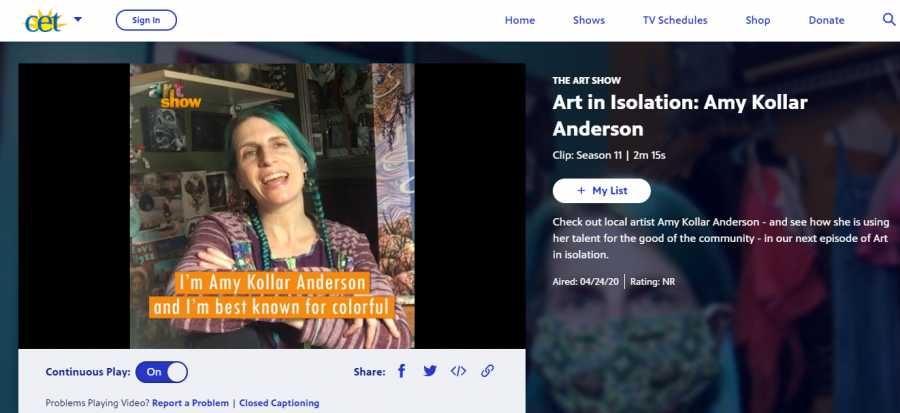Back to Broadcast: CET’s enlightening pandemic initiatives
For more than six decades, CET has been delivering educational programming to the Greater Cincinnati area. With shows to suit the tastes of any and every demographic, from young to old, home repair enthusiasts to budding chefs, astronomy experts to history junkies, CET has arguably turned the television screen into an intellectual refuge where all are welcome to gather.
However, in an era where streaming services reign dominant in the entertainment industry, some may be poised to argue that public television stations like CET are on rapidly on the track to becoming obsolete. The present is proving them otherwise.
As schools have been indefinitely closed, with students and teachers alike confined to homes, the Cincinnati hallmark company’s mission of education has never been more pertinent. Likewise, its commitment to covering the area’s fine arts scene has only been strengthened.
In response to the education and entertainment gap created by COVID-19, CET has pursued two new projects: “At Home Learning” and “Art in Isolation.”
With “At Home Learning,” CET has rearranged its educational programming schedule with a targeted audience for each time of the day through mid-June. The morning features shows for elementary-age children, such as Xavier Riddle and the Secret Museum. The early afternoon has programs for middle schoolers, including the science documentary series NOVA, and the afternoon’s content is aimed at high schoolers, with American Masters and The American Experience.
Such a redesign stemmed from certain homes having limited or no internet access. As schools move instruction online, some children find themselves at a disadvantage out of their control.
‘“We rearranged that schedule to make sure that everyone had access to educational opportunities, regardless of their internet situation,” Kellie May, Manager of Communications and Digital Initiatives at Public Media Connect, which is composed of both CET and Dayton-based ThinkTV, said.
Such a program was the brainchild of a television station on the West Coast. May said, that given the CET’s educational foundations, doing something similar was “not that much of a stretch for us.” Following a process of selecting and scheduling shows appropriate for a broad pool of ages, a schedule was finalized and distributed to other Ohio stations.
However, educational programming isn’t limited to broadcasting. “The accompaniment to that is, while we did it to make sure everyone has access, we also know that people who do have internet are watching it. So on our website, we’ve created a page that has accompanying online activities for every show that we air all day every day during that at home learning block,” May said.
CET additionally has a “Learning@Home” digital newsletter detailing educational activities for parents to do with their children. Meanwhile, SOITA, another part of the CET-ThinkTV organization, has been assisting teachers in learning how to utilize technology as an educational tool.
“So the challenge that we’ve had there is really that a lot of these workshops, and what we do for teachers in our community is done in person. So we’ve had to pivot those workshops to be offered online,” May said. “There are teachers who have never wanted to be or needed to be on those things, but now how to figure it out, like right now.”
“We have been trying to make sure that content that’s available from the PBS stations around the country is being shared… we know people are overwhelmed and that PBS is a trusted partner. So, you know if we can help cut that noise down a little bit and give them just a couple of things to do without overwhelming them, that’s what we want to do.
Educational materials aren’t limited to those who frequent the classroom. Currently, CET is pursuing “American Graduate,” a project from the Corporation for Public Broadcasting, and one years in the making. Originally conceived for preschoolers, the project has developed over time to target those poised on entering the workforce.
“I think what we’ll be moving into in the summer is looking at that American Graduate project with our current unemployment situation and the way the workforce has changed so quickly, and find out how we can support people in our community with learning opportunities,” May said.
The “Art in Isolation” program is an extension of The Art Show. The Art Show, a program co-produced by CET and ThinkTV, typically centers on the fine arts scene in both Cincinnati and Dayton. As an episode oftentimes takes an in-depth look into the lives of artists in their respective places of work and consists of multi-member production crews, standard episode creation could not continue.
“We feature meaningful, kind of substantive stories that dive into their process, and a lot of times share a lot more of the human stories behind the creators. And so when we were looking at what can we do… when our whole team, our whole creative production team needed to go into remote work… a lot of our active productions had to be postponed,” Mark Lammers, Executive Producer at Public Media Connect, said.
The idea for the program stemmed from Lammers’ frustration at being unable to continue to tell the stories of local art figures.
“It was hard to sit idly by when we have these original programs that we do,” Lammers said. “I found it really hard to just sit on my hands during this time and not be able to share this experience… I felt like art always speaks in meaningful ways no matter what’s occurring.”
Lammers partnered with May and another digital producer and editor to create the subseries. “We wanted to make sure that we could continue to at least throw something out into the ether that would continue to resound with the voice of these smaller artists, and I think we’ve done a pretty good job given the resources we’ve had,” Lammers said.
“Art in Isolation” still features regional artists and creative organizations, but through an entirely different lense, highlighting their methods of adjusting to a new life full of restrictions. The episodes are short, each lasting under 5 minutes, and offer a socially-distanced peak into the new lives of professionals from a variety of artistic disciplines, from painting to piano.
“I think it’s a really good mix of as many different art forms that we experience here at a local level, seen in a slightly different way seeing these artists, kind of in a more intimate and kind of personal confessional style,” Lammers said.
One episode covers the impact of the cancellation of senior showcases for the University of Cincinnati College Conservatory of Music’s Musical Theatre majors. Others feature regional artists such as Annie Lee-Zimerle, Dan Karlsburg, and Countess Winfrey explaining how pandemic-related restrictions have impacted their creative output.
As a result of social distancing requirements, all rely on video clips and images submitted by the subjects in response to previously-sent questions. However, the production team faced relatively few obstacles in gathering and compiling materials. “Really the biggest challenge I think is just selling a new idea to people that are not familiar,” Lammers said.
While The Art Show is typically broadcasted on television and available on CET’s website, “Art in Isolation” is only available online through the website and YouTube, and on CET’s social media pages.
“There’s an understanding that more people might be out there scrolling and looking for something meaningful and interesting, so we’re hoping to connect with those viewers just as much as our regular audience,” Lammers said.
For those, namely teenagers and young adults, who rely primarily on the internet and streaming services as their way of staying entertained, public broadcasting may not be the go-to means for educational enrichment or engagement. Both Lammers and May, however, are hopeful at the prospect of attracting new demographics to CET programming.
Your donation will support the student journalists of Walnut Hills High School. Your contribution will allow us to purchase equipment, cover our annual website hosting, printing costs and offset competition and conferences fees for students.






![A selection of students in Art X work individually on their projects during class. This class teaches students creative skills that they can apply both in and out of the classroom. “... If I have a pair of jeans that [have] a hole in them, I’ll embroider over them like cute flowers, or I’ll use the skills I learned in that class, and I’ll use them outside of school …”Sam Namaky, ‘27, said.](https://whhscbox.com/wp-content/uploads/2025/04/Group-Art-X-pic-2-600x400.jpg)

